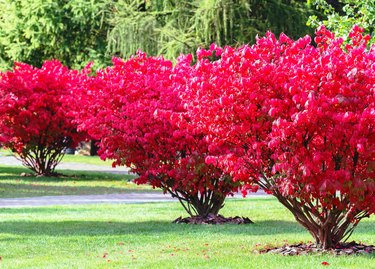
Burning bush or winged euonymus (Euonymus alatus, USDA hardiness zones 4-8) is grown for its foliage, so when the shrub begins to lose its leaves, it may be a blow to your landscaping plan. Cold injury can leave burning bush plants susceptible to pest invasion and disease. As a clue to tell you if your plants are stressed, watch for an early change in the coloring of the burning bush leaves.
Two-Spotted Spider Mites
Video of the Day
The two-spotted spider mite infests a wide range of plants, trees and shrubs, and the North Carolina State Extension website reports that they're particularly damaging to plants that are stressed. Mites cause further stress to plants, which can lead to an early change of color in burning bush foliage, browning of foliage and leaf drop. The mites are relatives of spiders. They prefer hot, dry conditions and produce several generations a year.
Video of the Day
To check for mites, hold a white sheet of paper beneath a branch, shake the bush and look for dark specks that drop onto the paper. To fight an infestation, spray your shrubs with hard blasts of water from the garden hose to wash away mites. The mites feed, shelter and create their webs beneath leaves, so direct the spray to the underside of foliage. Horticultural oils and miticides, such as malathion, can treat mites.
Scale and Winged Scale
Euonymus scale and winged euonymus scale damage burning bush plants by feeding, which leads to leaf drop and stress on plants. Infested plants are susceptible to winter injury.
Keep your plants adequately watered. Use pruning to treat limited infestations. The University of Illinois Extension website recommends using dormant oil spray when the plant isn't actively growing and insecticides to kill the crawlers -- the immature form of the euonymus alatus pest -- after eggs hatch. The cultivar 'Compactus' is resistant to euonymus scale, according to the Clemson University Cooperative Extension website.
Caterpillars and Defoliation
While not a major pest in every state, even small infestations of the euonymus caterpillar can lead to defoliation. The caterpillars start creating their webs on the tips of branches and move toward the interiors of affected shrubs. They can spread to affect entire shrubs. Damage is caused by larvae hatched the previous summer. These larvae begin to feed on foliage the following year in May or June.
Prune or remove any webbing and caterpillars. Insecticides, such as carbaryl and permethrin, are useful against these caterpillars. warns that growers should take care to ensure the insecticide penetrates the webbing for best results.
Environmental Stress and Euonymus Leaves Dropping Off
Environmental stress can cause decline in burning bush shrubs. The symptoms of stress include leaf drop, which can be severe and involve almost complete defoliation of shrubs. While cold injury occurs due to low temperatures, drought stress occurs when the shallow roots cannot uptake enough water and nutrients to sustain plants. Off-color, wilted, or dropped foliage is the result. Too much moisture is just as detrimental, leading to the death of root tissues and the decline of plants.